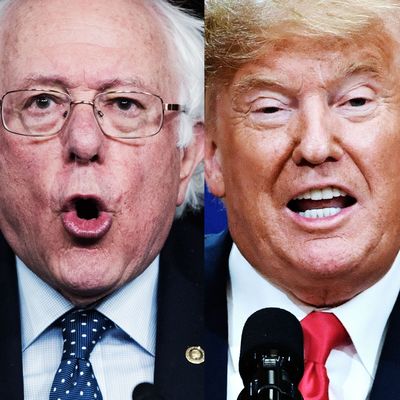
The last two years of fire and fury have not been kind to allies of Third Way, the centrist Democratic think tank that preaches a middle-of-the-road strategy focused on winning over independent voters and wooing back former Barack Obama supporters who swung to Donald Trump in 2016. These days it’s almost impossible to avoid resigned jokes among friends of the group about just how out of favor their Clintonphile politics supposedly are with the Democrats’ base. Late last week, as I walked into a hotel basement ballroom where Third Way was convening some of the country’s leading center-left officials in Columbus, Ohio, a strategist in attendance peered up from the Hilton pastries and texted me, wryly: “Welcome to the Wall St Wing of the Democratic Party.”
Back in Washington, Bernie Sanders and his newfound allies had laid claim to the party, tugging its leaders left as quickly as possible while pointing to 2016’s result as evidence that they were right all along. Just a few weeks earlier, Sanders, who of course lost that year’s presidential primary to Hillary Clinton, declared at a D.C. book party for his campaign manager, “In many ways, we did win the election.” The book is called How Bernie Won.
But in Ohio, more than 200 centrist lawmakers, operatives, and donors — including some former Hillary Clinton aides and backers — flew in from 20 of the country’s most politically relevant states to listen to a lot of speeches and panels and try to figure out how, exactly, their embattled faction could escape electoral isolation and spearhead a blue triumph in 2020. Third Way had spent the last two years conducting research and testing messages, and now — emerging from hours of strategy and policy sessions, polling-data slideshows, and Silicon Valley–style discussion about how best to influence the party’s disruptors — they were here to make clear to the insurgent progressive left that the center now intends to stand up and fight back, and that it has Sanders in its sights just as squarely as Donald Trump.
“Right now in the Democratic Party, there is only one option on the table: Sanders-style socialism. That’s the main option on the table. We’re doing this now because the party’s got to have a choice,” Jon Cowan, president of the think tank co-hosting the proceedings, with New York City real-estate executive Winston Fisher, told me. “It’s going to matter a hell of a lot in 2020, and so while 2020 may feel a ways off, in our mind it isn’t. And the ideas primary starts now. So we’re actually doing this for a very straightforward reason: to stand up and launch a serious, compelling economic alternative to Sanderism.”
A serious crowd had gathered two floors below us to hear about the first steps of this plan. Not only did the group include leading party pollsters and operatives, and influential local-level legislators, but also a pair of senators, a former governor, a handful of members of Congress, and at least four Democrats whose names have surfaced at some point in the national party’s great search for a champion to topple Trump in two years’ time. Yet over two days of hotel-coffee-powered chatter, the crowd also faced up to the reality that they’re still working on what, exactly, that fight is going to look like. And whether they can find any single person to lead it into the next presidential election.
***
A year and a half of exile was enough, Third Way’s leaders recently decided. So now the time was right to show some spine, which they hoped would trickle down to the lawmakers jockeying to lead the party.
“I know that a lot of the Berniecrats would like for this debate to be over, but, wow, that’s calling the debate over prematurely. The debate has barely even begun,” said Cowan, ticking off his evidence for the Sanders-wing Democrats’ weak claim to power: the senator lost the primary against Clinton, his post-campaign political organization has struggled to win marquee races, and a problematic single-payer health-care proposal reminiscent of Sanders’s Medicare for All rallying cry fell flat at the ballot box in Colorado in 2016. Addressing the audience that morning, Cowan introduced a new branding and policy direction that he hoped would drive the middle back to power. He called for the rise of the “Opportunity Democrats,” a line of messaging built out of extensive research that was then presented by Lanae Erickson Hatalsky, a Third Way vice-president whose online bio begins with her proud vote for Ross Perot in a fifth-grade mock election.
The new economic platform leans heavily on words like “earn” and “opportunity,” and away from demonizing tycoons — “For most Americans, billionaires and millionaires are not next door, or part of their lived experience,” Cowan said in his opening speech. The policy backbone of the pitch includes an American Investment Bank designed to back “Main Street, not Wall Street” entrepreneurs, a “Boomer Corps” part-time national-service program for senior citizens whose earnings would be tax-free (on top of their Social Security), a massive state-driven apprenticeship system, and universal private retirement savings accounts funded by employers.
Pulling up data from a large nationwide poll the group commissioned, combined with focus groups, Erickson Hatalsky explained that Americans, including Democrats and independents, were anxious about the future. But, she said, they were worried about the inequality of opportunity rather than the inequality of income by a healthy margin, and it was, in fact, upper-income citizens who reported worrying more about income than opportunity.
Over and over, she revealed how the group had tested its new, future-focused “Opportunity Democrat” line against what she called the “Sanders-style” version and the “Trump approach” alike, and how their approach repeatedly came out on top. The conference, it was by now clear, was not only a declaration of war against Sanders, but an implicit acknowledgement that Bill Clinton–era triangulation and its attendant nostalgia were politically stale, too. “The time has come to mend, but not end, capitalism for a new era,” Cowan told the audience, in a speech where he also declared, “Big isn’t enough. If it’s bold and old, it’s simply old.”
“Let’s be clear. Eighties-style supply-side, ’90s centrism, and ’60s socialism will not cut it for the era we live in,” he conceded.
Before Delaware senator Chris Coons spoke on Friday morning, the sound system appeared to be sending a message. “Don’t Stop Believing,” it insisted.
***
Fights for the party’s future are nothing new for Third Way, which was founded in the post–John Kerry, pre-Obama era. The centrists’ theory of the 2020 case is that once that election fully breaks out after November, it will begin with a pair of pre-primaries: one to get to Sanders’s left, and one to become the face of “Opportunity.” The lessons of 2016 loom large.
The centrist crew is convinced that its message is a winning one in both a Democratic primary electorate and nationwide — “An opportunity narrative resonates broadly and deeply with the very voters Democrats need to win in 2018 and 2020,” said Erickson Hatalsky — and that by seeding it in the minds of so many party activists now, they can get a handful of serious 2020 contenders onto their half of the primary bracket early. Strategists at the session said this task would likely prove easier after the midterms, especially when (if) Democrats win a House majority that will likely be built by rookie moderates from purple suburban areas and some red enclaves, rather than Alexandria Ocasio-Cortez–style progressives from already deep-blue districts.
Yet at the core of their pitch is a fundamental belief that one of the party’s central debates is whether to tack toward swing voters, or to run a base-first national election. There was little room for doubt here that Clinton did too much of the latter, and that Sanders’s approach represents a full embrace of that side. (And it was always Sanders who came up when the centrists spoke of the left, never Elizabeth Warren or any other potential lefty standard-bearer.)
But to many of the party’s leaders, including much of the 2020 crowd, the base-voters versus swing-targets discussion itself is antiquated. So who, exactly, will make Third Way’s pitch when the primaries become real?
“Everybody’s got a camera on their phone. That never worked, but it really doesn’t now: You can’t just go and say one thing to one group and another to another group,” said Jason Kander, the former Missouri secretary of state who last month opted to run for Kansas City mayor rather than president, making the case onstage that you lose both the base and swing voters if you try to differentiate between them.
Another featured speaker plucked from the potential 2020 list, Ohio congressman Tim Ryan, addressed the conference just a day after being unveiled as an inaugural member of the House’s new Medicare for All Caucus. When I asked if this wasn’t a bit of a contradiction — showing up to a Third Way conference after associating with Sanders’s signature policy proposal — he brushed the concern aside. “No,” he said, insisting there’s far less distance between the two sides than even the event’s organizers might think. “It’s how you talk about it.”
And though 2020 was the stated topic both onstage and in the hotel hallways outside the main ballroom, there was surprisingly little chatter about former vice-president Joe Biden, or other possible White House hopefuls who could reasonably take up the center’s cause, like — perhaps — Colorado governor John Hickenlooper or Cory Booker. Others, like Kirsten Gillibrand or Kamala Harris, had already drifted too far left for much of the crowd. No one mentioned Tim Kaine.
The closest thing to a conference consensus by its end was that there was, at least, hope in one participant who, early in his onstage discussion, repeated that he had not yet shut the door entirely on running for president, even if he seemed to be leaning hard against it. Former New Orleans mayor Mitch Landrieu — the charismatic southern outsider who privately lunched on Friday with a pair of the think tank’s leaders who had both worked in the Clinton administration — hit his notes precisely, giving the crowd a glimmer of hope that the shadow of 2016 may soon be lifted from the Democratic center.
“The Republicans have chosen their [path], they’re going to run a base election, which means they have ceded the middle of the road,” Landrieu said that morning, just as Virginia senator Mark Warner, a past Great Centrist Hope of many conference participants, quietly walked into the room. “In my opinion, Democrats would be making a big mistake if they run a base election. We have to find common ground.”
It was what this audience wanted to hear. He wrapped up, and the speakers crackled back to life. “Fight Song.” Hillary Clinton’s anthem.






























